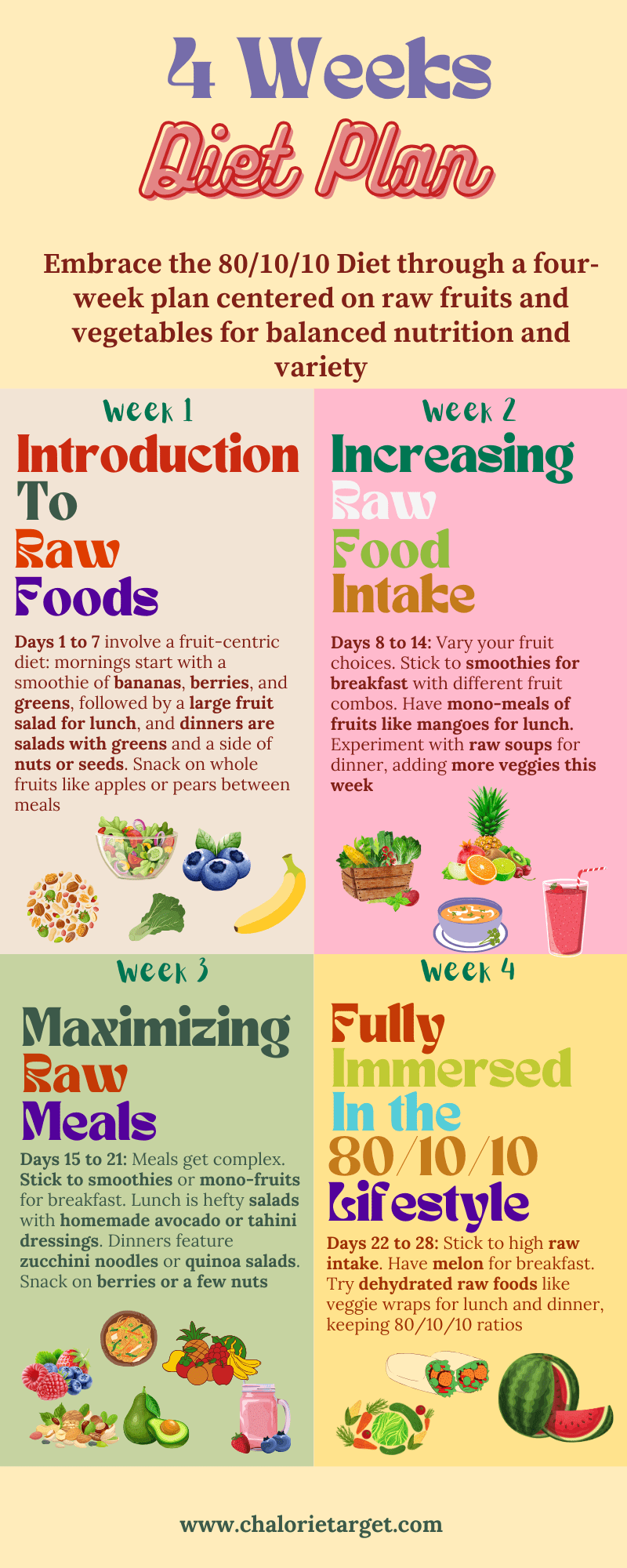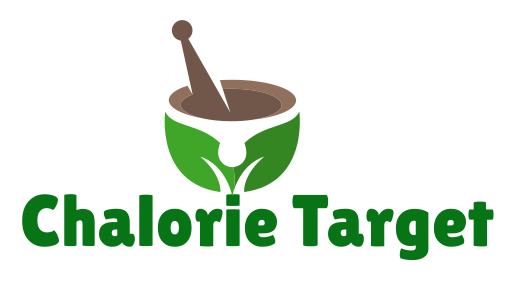The 80/10/10 Diet prioritizes a high intake of raw fruits and vegetables, advocating for 80% of calories from carbohydrates, 10% from protein, and 10% from fats. Dr. Douglas Graham designed this Diet to emphasize whole, unprocessed foods to promote health and well-being. Its simplicity and focus on natural foods aim to optimize digestion and energy levels.
In health and wellness, the 80/10/10 Diet has surfaced as a topic of interest among diet-conscious individuals. This dietary approach, emphasizing a plant-based lifestyle, promises weight management, improved energy levels, and overall health.
This blog post dives deep into the principles, benefits, potential drawbacks, and real-life applications of the 80/10/10 Diet.
1. What is 80/10/10 Diet? Brief History and Origin
The 80/10/10 Diet, meticulously developed by Dr. Douglas N. Graham, who holds a venerable position within the raw food community, promotes a diet that is principally low in fat and based entirely on plant sources. This dietary approach is distinct in its macronutrient distribution, as encapsulated by the figures in its vocabulary.
The numbers—80% carbohydrates, 10% protein, and 10% fat—represent the precise ratio of macronutrients, calculated by calorie intake, that adherents are encouraged to follow.
This Diet underscores the importance of consuming whole, unprocessed plant foods to achieve a balance that supports optimal health and vitality, reflecting Dr. Graham’s advocacy for a lifestyle that harmonizes closely with nature’s intended dietary patterns for humans.
Summary
The 80/10/10 Diet advocates for a low-fat, plant-based diet with 80% of calories from carbohydrates and 10% each from proteins and fats. It emphasizes consuming whole, unprocessed plant foods to promote optimal health and vitality.
Read More: What is Typically a Characteristic of a Vegetarian Diet?
2. The Science Behind the 80/10/10 Diet
The dietary approach under discussion emphasizes consuming raw fruits and vegetables as the primary source of nutrition, advocating that a carbohydrate-rich diet can fuel the body more effectively than diets heavy on proteins and fats.
This philosophy is grounded in the belief that a higher intake of unprocessed plant-based foods results in better digestion, elevated energy levels, and more efficient absorption of nutrients due to the natural enzymes and higher fiber content in raw produce.
Proponents of this Diet argue that by adhering to these principles, individuals can improve their overall health, support bodily functions more optimally, and potentially prevent various diseases by ensuring their body receives many vitamins, minerals, and antioxidants abundantly available in fruits and vegetables.
This raw food diet seeks to maximize the nutritional intake by consuming foods in their most natural state. It encourages a holistic approach to well-being, emphasizing the importance of nourishing the body with what they consider to be the most life-giving and energy-providing foods available.
Summary
The 80/10/10 Diet emphasizes eating raw fruits and vegetables for a nutrient-rich, plant-based Diet that boosts digestion, energy, and health. It advocates for a high-carb, low-fat approach, focusing on whole foods for better nutrient absorption and well-being.
3. What to Eat on the 80/10/10 Diet
The essence of the 80/10/10 Diet by Dr. Douglas Graham is to eat predominantly fruits and vegetables, making them the staple of every meal. Adequate hydration is emphasized, focusing on consuming plenty of water-rich fruits such as watermelons, oranges, and cucumbers to help meet daily fluid intake requirements.
Leafy greens and soft, ripe fruits are at the heart of this Diet, providing the necessary nutrients and energy to sustain an active lifestyle. Staples include bananas, apples, berries, and mangoes for their high carbohydrate content and avocados, nuts, and seeds in moderation for essential fats.
a. Recommended Foods
- Fresh fruits (e.g., bananas, berries, citrus)
- Leafy greens and vegetables
- Small portions of nuts and seeds
b. Restricted Foods
- Animal products
- Processed foods
- High-fat plant foods (e.g., avocados in excess)
d. Meal Planning Tips
Incorporating a variety of fruits and vegetables into each meal ensures nutrient diversity. Smoothies, salads, and raw soups can be staples in this Diet.
Summary
The 80/10/10 Diet promotes health with a raw, plant-based diet. Focusing on fruits and vegetables for nutrition, it aims to improve digestion, energy, and overall health.
Read More: How to Incorporate More Beans into your Diet?
4. Health Benefits of the 80/10/10 Diet
The health benefits of the 80/10/10 Diet are manifold and significant, primarily attributed to its foundation of high nutrient-dense, whole, raw plant foods. Adherents often report a noticeable increase in energy levels, improved digestion due to high fiber intake, and clearer skin, attributable to fruits and vegetables’ hydrating and detoxifying properties.
Furthermore, the Diet’s low fat and high carbohydrate ratio can contribute to weight loss and maintenance within healthy parameters, as it promotes a feeling of fullness with fewer calories and minimally processed food consumption.
The high intake of antioxidants and essential nutrients from a diverse range of fruits and vegetables also plays a crucial role in disease prevention. Bolstering the body’s immune system and reducing the risk of chronic conditions such as heart disease, diabetes, and certain cancers.
Summary
The 80/10/10 Diet focuses on raw fruits and vegetables, boosting energy, digestion, and weight control. It advocates for a sustainable lifestyle with low-fat, high-carb eating for better personal and environmental health.
5. 4 Weeks Diet Plan

Adopting the 80/10/10 Diet requires a structured plan to transition smoothly into a lifestyle emphasizing raw fruits and vegetables. Below is a four-week diet plan designed to gradually introduce the body to this eating method while ensuring nutritional balance and variety.
a. Week 1: Introduction to Raw Foods
- Day 1 to 7: Begin each day with a large fruit smoothie for breakfast, incorporating bananas, berries, and a handful of greens. For lunch, opt for a giant fruit salad topped with squeezed orange juice. Dinner can consist of a large salad with various greens, topped with a small portion of nuts or seeds for your fat intake. Snack on whole fruits like apples or pears whenever you are hungry between meals.
b. Week 2: Increasing Raw Food Intake
- Day 8 to 14: Start diversifying your fruit intake. Breakfast can remain a large smoothie, but try different combinations of fruits and greens. Lunch could be large mono-meals of fruit, such as mangoes or peaches, providing variety and simplicity. For dinner, experiment with raw soups alongside your salad. Include a wider variety of vegetables this week.
c. Week 3: Maximizing Raw Meals
- Day 15 to 21: Introduce more complexity into your meals. Continue with fruit smoothies or mono-fruit meals for breakfast. For lunch, prepare sizable salads with colorful vegetables topped with homemade dressings from avocado or tahini (in small amounts). Dinners can include zucchini noodles with raw tomato sauce or large salads with sprouted quinoa. Snack on fresh berries or small quantities of nuts.
d. Week 4: Fully Immersed in the 80/10/10 Lifestyle
- Day 22 to 28: Keep breakfast simple with melon or another water-rich fruit. Experiment with lunch and dinner by incorporating dehydrated raw foods like crackers or wraps filled with various vegetables and a small amount of avocado or seed spread to stick with the 80/10/10 macro ratios. Try different herbs and spices to add flavors to your meals without compromising the Diet’s principles.
e. Expected Results After 4 Weeks
After following the diet for four weeks, individuals often report noticeable improvements in their overall health. Expected outcomes include weight loss due to the low-fat, high-fiber nature of the Diet and a significant increase in energy levels attributed to the high intake of raw fruits and vegetables.
Improved digestion is another frequently observed benefit, as the Diet is rich in natural enzymes and water, aiding in smoother digestion and absorption of nutrients. Experiment with different fruits and vegetables to discover meals that you enjoy.
A perk in mental clarity and skin health may also be evident due to the Diet’s emphasis on nutrient-dense, hydrating foods.
Summary
The 4-week diet plan offers a gradual introduction to the 80/10/10 Lifestyle, emphasizing consuming raw fruits and vegetables to improve overall health and well-being. Each week builds upon the last, increasing the variety and complexity of meals to fully adapt to a high raw food intake.
Read More: How to Make Low Calorie Bread?
6. Potential Drawbacks and Solutions
a. Nutrient Deficiencies
One of the primary concerns with the diet is the risk of nutrient deficiencies, particularly in protein, essential fatty acids, and specific vitamins like B12, which are naturally absent in plant foods.
Long term adherence to such a restrictive diet may require careful planning or supplementation to avoid potential health issues associated with these deficiencies. Incorporating a broader variety of nuts, seeds, and leafy greens and considering B12 supplements can help mitigate these risks.
b. Social and Lifestyle Challenges
Adopting an 80/10/10 diet can introduce significant social and Lifestyle changes, as dining out or attending social events may become more challenging. The restrictive Diet may limit options at traditional restaurants and require additional planning for social gatherings.
Building a supportive community, either online or locally, and planning meals can assist in navigating these challenges and sustaining this lifestyle choice.
c. Adaptive Strategies for Success
To successfully maintain the 80/10/10 Diet, individuals must be adaptable and knowledgeable about their nutritional intake. It’s crucial to listen to the body’s signals and adjust as needed.
This might include increasing the intake of certain foods if energy levels dip or consulting with a healthcare provider to address possible nutrient gaps. Education on raw food preparation, creative meal planning, and staying informed about nutritional Science can empower individuals to thrive while following this Diet.
Summary
The 80/10/10 diet, while promoting health benefits through raw fruits and vegetables, poses challenges like nutrient deficiencies and social constraints. Adaptive strategies and informed choices are key to navigating these potential drawbacks successfully.
Read More: Can You Eat Chicken Salad While Pregnant? Understanding the Risks and Benefits
7. Conclusion and Call to Action
The 80/10/10 Diet represents a radical shift from conventional dietary patterns, focusing on raw, plant-based eating. While it offers numerous benefits, including weight loss and improved vitality, potential followers should approach the Diet with a plan to ensure nutritional adequacy.
For those intrigued by the promise of the 80/10/10 Diet, further exploration and consultation with healthcare professionals knowledgeable about plant-based nutrition is recommended. Engaging with resources such as Dr. Douglas N. Graham’s The 80/10/10 Diet book, reputable websites like NutritionFacts.org, and academic publications from Harvard Health Publishing can offer valuable insights.
In the words of Dr. Graham, “The 80/10/10 Diet is more than just a diet; it’s a lifestyle.” This Lifestyle demands commitment but promises a return of unparalleled health and wellness.
